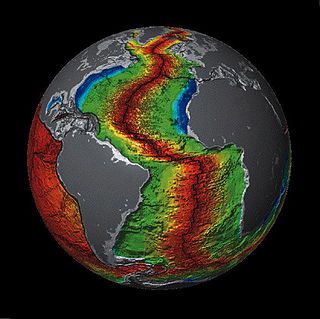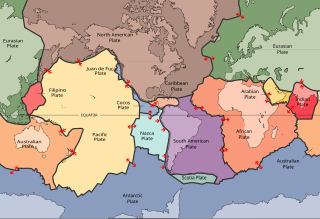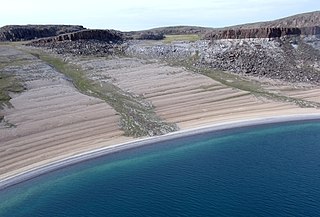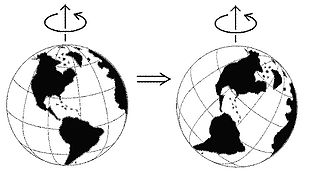 W
WGeodynamics is a subfield of geophysics dealing with dynamics of the Earth. It applies physics, chemistry and mathematics to the understanding of how mantle convection leads to plate tectonics and geologic phenomena such as seafloor spreading, mountain building, volcanoes, earthquakes, faulting and so on. It also attempts to probe the internal activity by measuring magnetic fields, gravity, and seismic waves, as well as the mineralogy of rocks and their isotopic composition. Methods of geodynamics are also applied to exploration of other planets.
 W
WBoris Choubert or Schuberth was a French geologist. An adept of Wegener's theory, he was the first to precisely reconstruct the layout of the continental masses of Africa, America, Europe and Greenland prior to the fragmentation of Pangaea, thirty years before the article generally credited for this discovery.
 W
WEarth's crustal evolution involves the formation, destruction and renewal of the rocky outer shell at that planet's surface.
 W
WEarth's internal heat budget is fundamental to the thermal history of the Earth. The flow of heat from Earth's interior to the surface is estimated at 47±2 terawatts (TW) and comes from two main sources in roughly equal amounts: the radiogenic heat produced by the radioactive decay of isotopes in the mantle and crust, and the primordial heat left over from the formation of Earth.
 W
WThe expanding Earth or growing Earth hypothesis asserts that the position and relative movement of continents is at least partially due to the volume of Earth increasing. Conversely, geophysical global cooling was the hypothesis that various features could be explained by Earth contracting.
 W
WThe discovery of extrasolar Earth-sized planets has encouraged research into their potential for habitability. One of the generally agreed requirements for a life-sustaining planet is a mobile, fractured lithosphere cyclically recycled into a vigorously convecting mantle, in a process commonly known as plate tectonics. Plate tectonics provide a means of geochemical regulation of atmospheric particulates, as well as removal of carbon from the atmosphere. This prevents a “runaway greenhouse” effect that can result in inhospitable surface temperatures and vaporization of liquid surface water. Planetary scientists have not reached a consensus on whether Earth-like exoplanets have plate tectonics, but it is widely thought that the likelihood of plate tectonics on an Earth-like exoplanet is a function of planetary radius, initial temperature upon coalescence, insolation, and presence or absence of liquid-phase surface water.
 W
WGeothermal gradient is the rate of increasing temperature with respect to increasing depth in Earth's interior. Away from tectonic plate boundaries, it is about 25–30 °C/km (72–87 °F/mi) of depth near the surface in most of the world. Strictly speaking, geo-thermal necessarily refers to Earth but the concept may be applied to other planets.
 W
WInner core super-rotation is a theorized eastward rotation of the inner core of Earth relative to its mantle, for a net rotation rate that is faster than Earth as a whole. A 1995 model of Earth's dynamo predicted super-rotations of up to 3 degrees per year; the following year, this prediction was supported by observed discrepancies in the time that p-waves take to travel through the inner and outer core.
 W
WIsostatic depression is the sinking of large parts of the Earth's crust into the asthenosphere. The sinking is caused by a heavy weight placed on the Earth's surface. Often this is caused by the heavy weight of glacial ice due to continental glaciation. This is a process in which permanent ice places pressure on the Earth's crust, thereby depressing it with its weight. After continental glaciation has receded, it is common for isostatic rebound to occur.
 W
WThe lithospheric flexure is the process by which the lithosphere bends under the action of forces such as the weight of a growing orogen or changes in ice thickness related to (de)glaciations. The lithosphere is the thin, outer, rigid layer of the Earth resting on the asthenosphere, a viscous layer that in geological time scales behaves as a fluid. Thus, when loaded, the lithosphere progressively reaches an isostatic equilibrium, which is the name of the Archimedes principle applied to these geological settings.
 W
WMantle convection is the very slow creeping motion of Earth's solid silicate mantle caused by convection currents carrying heat from the interior to the planet's surface.
 W
WA mantle plume is a proposed mechanism of convection of abnormally hot rock within the Earth's mantle. Because the plume head partly melts on reaching shallow depths, a plume is often invoked as the cause of volcanic hotspots, such as Hawaii or Iceland, and large igneous provinces such as the Deccan and Siberian traps. Some such volcanic regions lie far from tectonic plate boundaries, while others represent unusually large-volume volcanism near plate boundaries.
 W
WNutation is a rocking, swaying, or nodding motion in the axis of rotation of a largely axially symmetric object, such as a gyroscope, planet, or bullet in flight, or as an intended behaviour of a mechanism. In an appropriate reference frame it can be defined as a change in the second Euler angle. If it is not caused by forces external to the body, it is called free nutation or Euler nutation. A pure nutation is a movement of a rotational axis such that the first Euler angle is constant. In spacecraft dynamics, precession is sometimes referred to as nutation.
 W
WPlate tectonics is a scientific theory describing the large-scale motion of seven large plates and the movements of a larger number of smaller plates of Earth's lithosphere, since tectonic processes began on Earth between 3.3 and 3.5 billion years ago. The model builds on the concept of continental drift, an idea developed during the first decades of the 20th century. The geoscientific community accepted plate-tectonic theory after seafloor spreading was validated in the late 1950s and early 1960s.
 W
WPost-glacial rebound is the rise of land masses after the removal of the huge weight of ice sheets during the last glacial period, which had caused isostatic depression. Post-glacial rebound and isostatic depression are phases of glacial isostasy, the deformation of the Earth's crust in response to changes in ice mass distribution. The direct raising effects of post-glacial rebound are readily apparent in parts of Northern Eurasia, Northern America, Patagonia, and Antarctica. However, through the processes of ocean siphoning and continental levering, the effects of post-glacial rebound on sea level are felt globally far from the locations of current and former ice sheets.
 W
WTrue polar wander is a solid-body rotation of a planet or moon with respect to its spin axis, causing the geographic locations of the north and south poles to change, or "wander". If a body is not totally rigid, then in a stable state, the largest moment of inertia axis will be aligned with the spin axis, with the smaller two moments of inertia axes lying in the plane of the equator. If the body is not in this steady state, true polar wander will occur: the planet or moon will rotate as a rigid body to realign the largest moment of inertia axis with the spin axis.